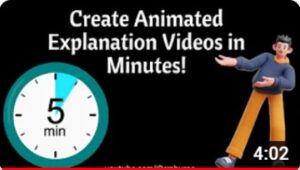In this post, we’re looking at AI tools that let you turn text into videos. In some cases, it will even write the text for you! We all know that it’s challenging to keep students engaged in an increasingly digital world. Using videos more often is one way to capture their attention.
Exploring AI Video Creation Tools for Educators
AI-powered video creation platforms are a game-changer for teachers– and there are a lot of tools to choose from.
Each AI video creation platform offers unique features that can aid in different aspects of teaching. Here’s a rundown of some of the best tools out there.
Simpleshow.com
Simpleshow makes video creation as simple as typing out a lesson plan. Its AI-driven interface helps educators create animated videos that explain complex concepts in simple terms. Whether it’s a tricky math problem or a historical event, simpleshow can help you break it down into easily digestible visuals.
 Richard Byrne did a an in-depth video on how simpleshow.com works using the free version. Click to watch him in action.
Richard Byrne did a an in-depth video on how simpleshow.com works using the free version. Click to watch him in action.
Animaker
Animaker is a user-friendly platform that empowers teachers to create animated videos effortlessly. Its robust library of animations, stock footage, and images means that creating a video is as easy as dragging and dropping elements into place. This tool is excellent for crafting animated timelines or science experiments, bringing them to life for students.
Kapwing
Kapwing’s AI Video Generator specializes in converting text descriptions into draft videos. This feature is particularly useful for literature and social studies teachers who want to visualize storylines or historical accounts, providing a foundation for further class discussion and analysis.
Invideo
Invideo’s full AI video generator is designed for ease from the get-go. Unique and tailored videos can be generated for any topic, making it perfect for bespoke educational content, like personalized story problems in math or hypothetical scientific scenarios that challenge students to think critically.
Canva
Canva allows for high customization in video creation, enabling educators to create multilingual content using a vast selection of AI voices. This is a fantastic resource for language educators, allowing them to produce interactive scenarios in which AI avatars engage in dialogue in the target language, thus enriching language acquisition.
Synthesia
Synthesia shines with its quick text-to-video conversion and a multitude of AI voices across different languages, ideal for diverse classrooms. This tool can help teachers create instructional videos in multiple languages or provide summaries of lessons for students who need them.
Steve.AI
Steve.AI offers animated videos with lip-syncing avatars, excellent for visual storytelling or explaining abstract concepts in a more tangible way. English teachers, for instance, could animate a piece of literature, providing a visual and auditory representation that could lead to better retention and understanding.
Putting AI Video Tools to Work for You, the Teacher
Incorporating these AI tools into your educational toolkit is straightforward. Begin by pinpointing a lesson that could be enhanced by a visual element. Select a platform that aligns with your objectives and use the resources available to create content that will engage your students. The aim is to supplement—not replace—the invaluable human element of teaching. With these AI video tools, you can bring lessons to life– along with your students!










